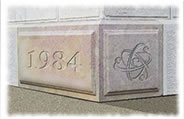Setting and Re-Setting Cornerstones
I was lost, late and frustrated on a country road in Louisiana. I asked directions from an old gentleman, who said, “Go down the road a piece, turn left where the old oak tree used to be. Go on ‘bout five miles. You’ll meet up with the freeway presently!”
He was so matter of fact about it. I had gone a “piece” before I realized I had no earthly idea where the old oak tree used to be! His “Landmark” was REAL (in his mind) long after the actual tree was history. That memory had substance and meaning for him that no outsider could understand. But the Landmark was history.
Landmarks (trees, clock towers, buildings, etc.) assist us in navigating from place to place, then to firmly locate ourselves once we’ve arrived “Hey. I’m in New York, at the Waldorf, under the clock!
In a crisis, a hurricane for example, the Landmarks get all jumbled — crushed, even washed away.
And people have a terrible time finding themselves when their Landmarks are gone. What a terrible shock! Your home, your town, your place of employment, your world as you knew it is… GONE!
But it gets worse. Landmarks are mere physical things, but with our capable imagination, we can make anything: a memory, a whiff of perfume, a bit of music, even a person — into a mental landmark which we call a Cornerstone. Cornerstones allow us to mark and hold space in the mind.
After a crisis (or a corporate re-org or an economic downturn) there’s physical damage and debilitating change, but that’s just the visible stuff. What’s perhaps more insidious is the damage you can’t see: the disorientation and the sense of hopelessness. As one of our neighbors observed after a hurricane, “That storm didn’t just mess with our house, it also messed with our heads and our hearts!”
Noticing how ruinous it seemed when disaster overturned all the trees, clock towers and homes, it became slowly clear to me that the damage was not just physical, but also intellectual and spiritual.
There was safety at risk, but also orientation (“Where am I?”), and certainty… (“Who am I?”)
If the things we identify with are destroyed, our very identity can seem to be at risk as well.
It turns out, we “identify” with our physical, mental and spiritual markers and take some measure of our “personhood” from each — our work, our partners, our homes, towns, cars, industries and nation. When change happens, many of our Cornerstones can apparently be overturned, dislodged or destroyed — with powerful effect.
We believe it’s the job of Leaders, in the Family, the Town, the Workplace and the Nation to “Put Cornerstones in Place.” To explain the game to the players. To make it clear what we do here, what we stand for, and how we play. Also, to re-install or recover Cornerstones after a crisis — when people desperately need to re-orient themselves — physically, mentally and spiritually.
You can decide to lay a Cornerstone in the beginning, but also (and perhaps more importantly) re-set one after a crisis. And, sometimes you can decide that an old Cornerstone has outlived its usefulness, remove it, and begin again.
After all, the old oak tree is long gone…
Applications
1. Individually
The first challenge in life is to select your own Cornerstones which comprise the boundaries of your universe and your own unique point of view. What am I here for? How do I want to work, play and connect with others? Where do I choose to live? What is important to me? And how do I make this known to others?
2. At Home
Work to explain the family’s Cornerstones to all the members, so they’re not just assumed, but really understood. (It’s the intangible Cornerstones that are sometimes the hardest to make clear.) Have they moved, or shifted a little over time?
3. At Work
Seek to discover what the Cornerstones actually are! What do we do here? Why? What do we stand for? For what kind of exchange? What style, attitude and methods make this place unique? What’s my “place?” How do I fit in?
4. As a Manager
You are the Director of Orientation! “Here’s the game. Here’s how we do it. Here’s what makes us special. Here’s your role. Get to it!”
The hardest thing after a crisis (or any form of change) is “getting back to it.” Establishing, re-discovering, maintaining and putting people back in touch with Cornerstones (another word for Reality) can help everyone reorient and rediscover “where the old oak tree used to be!”
Subscribe to our Newsletter


